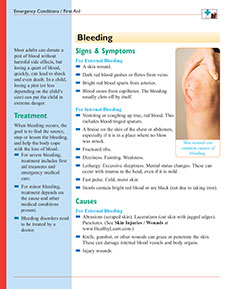CONDITIONS
SYMPTOM CHECKER
Male
Female
Child
Arm, Hand & Shoulder Concerns
Legs & Feet Concerns
Dental & Mouth Concerns
Ear & Nose
Eye Conditions
Head Conditions
Arm, Hand & Shoulder Concerns
Legs & Feet Concerns
Front
Back
Arm, Hand & Shoulder Concerns
Dental & Mouth Concerns
Ear & Nose
Eye Conditions
Head Conditions
Arm, Hand & Shoulder Concerns
Dental & Mouth Concerns
Ear & Nose
Eye Conditions
Head Conditions
Front
Back
Arm, Hand & Shoulder Concerns
Neck Links
Head & Neck Concerns
Arm, Hand & Shoulder Concerns
Neck Links
Head & Neck Concerns
Front
Back
Online Clinic
Wise Healthcare
Bleeding
Print on Demand
RELATED ARTICLES
Most adults can donate a pint of blood without harmful side effects, but losing a quart of blood, quickly, can lead to shock and even death. In a child, losing a pint (or less depending on the child’s size) can put the child in extreme danger.
Burns
• A skin wound.
• Dark red blood gushes or flows from veins.
• Bright red blood spurts from arteries.
• Blood oozes from capillaries. The bleeding usually clots off by itself.
For Internal Bleeding
• Vomiting or coughing up true, red blood. This includes blood-tinged sputum.
• A bruise on the skin of the chest or abdomen, especially if it is in a place where no blow was struck.
• Fractured ribs.
• Dizziness. Fainting. Weakness.
• Lethargy. Excessive sleepiness. Mental status changes. These can occur with trauma to the head, even if it is mild.
• Fast pulse. Cold, moist skin.
• Stools contain bright red blood or are black (not due to taking iron).
Causes
For External Bleeding
• Abrasions (scraped skin). Lacerations (cut skin with jagged edges). Punctures.
• Knife, gunshot, or other wounds can graze or penetrate the skin. These can damage internal blood vessels and body organs.
• Injury wounds.
For Internal Bleeding
• A bruise. This is bleeding from and damage to tissues beneath the skin.
• Damage to blood vessels and/or internal structures. This includes a blunt injury that does not break the skin, a bleeding ulcer, and an aneurysm.
• Bleeding disorders.
Treatment
When bleeding occurs, the goal is to find the source, stop or lessen the bleeding, and help the body cope with the loss of blood.
• For severe bleeding, treatment includes first aid measures and emergency medical care.
• For minor bleeding, treatment depends on the cause and other medical conditions present.
• Bleeding disorders need to be treated by a doctor.
Questions to Ask
Question 1
Are any of these problems present?
• A body part has been amputated.
• Bleeding from a wound is severe.
• Blood spurts from the wound and it is not controlled with direct pressure.
• Signs of shock.
Get medical care without delay. If symptoms are life threatening go to the ER or call 9-1-1. Don’t call 9-1-1 or use the ER if symptoms do not threaten life. Ask your doctor ahead of time where you should go for a problem that needs prompt care, but not emergency care.
Question 2
Are any of these problems present?
• Bleeding comes from a deep wound (it appears to go down to the muscle or bone) and/or a bone is exposed.
• The skin on or around the wound site hangs open.
• A deformity is at the injury site.
• Bleeding from what appears to be a minor wound continues after 20 minutes of applied pressure.
Get medical care without delay. If symptoms are life threatening go to the ER or call 9-1-1. Don’t call 9-1-1 or use the ER if symptoms do not threaten life. Ask your doctor ahead of time where you should go for a problem that needs prompt care, but not emergency care.
Question 3
Are any signs of internal bleeding present? (Note: These may take days after an injury to occur.)
Get medical care without delay. If symptoms are life threatening go to the ER or call 9-1-1. Don’t call 9-1-1 or use the ER if symptoms do not threaten life. Ask your doctor ahead of time where you should go for a problem that needs prompt care, but not emergency care.
Question 4
Does a person with a bleeding disorder or who takes blood-thinning medicine have a hard time controlling bleeding?
Get medical care without delay. If symptoms are life threatening go to the ER or call 9-1-1. Don’t call 9-1-1 or use the ER if symptoms do not threaten life. Ask your doctor ahead of time where you should go for a problem that needs prompt care, but not emergency care.
Question 5
Does a person with a bleeding disorder or who takes blood-thinning medicine have a minor wound?
You should be seen by your doctor for medical advice. Contact your doctor or health care provider to find out how soon you should be seen.
Question 6
Are any of these problems present?
• Small red dots or clusters of small, pinpoint-sized red specks under the skin. Easy bruising.
• Frequent nose bleeds. Excessive bleeding from cuts.
• In females, excessive or prolonged menstrual bleeding or vaginal bleeding after menopause.
• Blood in the urine or stools.
You should be seen by your doctor for medical advice. Contact your doctor or health care provider to find out how soon you should be seen.
Use Self-Care / First Aid:
You can probably take care of the problem yourself if you answered NO to all the questions. Use the “Self-Care” measures that are listed. Call your doctor if you don’t feel better soon, though. You may have some other problem.
Self-Care / First Aid
For Severe Bleeding
• Without delay, apply direct pressure to the wound using a sterile dressing or clean cloths. {Note: If the cut is large and the edges of it gape open, pinch the edges of the wound while you apply pressure.}
• Call 9-1-1 or take the person to nearest hospital emergency department.
• Do not remove an object that is stuck in a wound. Pack it in place with padding. Put tape around the padding so it doesn’t move.
• If bleeding continues before getting medical help, put extra cloths, etc. on top of existing ones. Keep putting pressure on the wound until bleeding stops or until medical help takes over.
• The most important thing to do is to apply direct pressure on the bleeding site. Some health experts advise to do these things, too, if needed:
– Elevate the wounded area higher than heart level while applying pressure. Do this if no bone is broken.
– Apply pressure to a “pressure point” if bleeding still continues after 15 to 20 minutes of direct pressure. Use the pressure point closest to the bleeding site that is between the wound and the heart. (See Pressure Points.)
• Don’t apply a tourniquet except to save a life.
• While giving first aid for bleeding, keep looking for signs of shock.
For an Amputation
• Control bleeding.
• Wrap the severed part in a clean, dry (not wet) cloth or sterile gauze. Place the wrapped part in a plastic bag or other waterproof container. Put these on a bed of ice. Do not submerge the severed part in cold water or ice.
For Bleeding from the Scalp
• Use a ring pad to apply pressure around the edges of the wound, not on the wound. Make a ring pad (shaped like a doughnut) with a bandage of narrow, long strips of cloth. Start with one end of the narrow bandage and wrap it around all four fingers on one hand until you form a loop. Leave a long strip of the bandage material to weave in and around the loop so it doesn’t unravel.
This website is not meant to substitute for expert medical advice or treatment. Follow your doctor’s or health care provider’s advice if it differs from what is given in this guide.
The American Institute for Preventive Medicine (AIPM) is not responsible for the availability or content of external sites, nor does AIPM endorse them. Also, it is the responsibility of the user to examine the copyright and licensing restrictions of external pages and to secure all necessary permission.
The content on this website is proprietary. You may not modify, copy, reproduce, republish, upload, post, transmit, or distribute, in any manner, the material on the website without the written permission of AIPM.
2021 © American Institute for Preventive Medicine - All Rights Reserved. Disclaimer | www.HealthyLife.com
















































